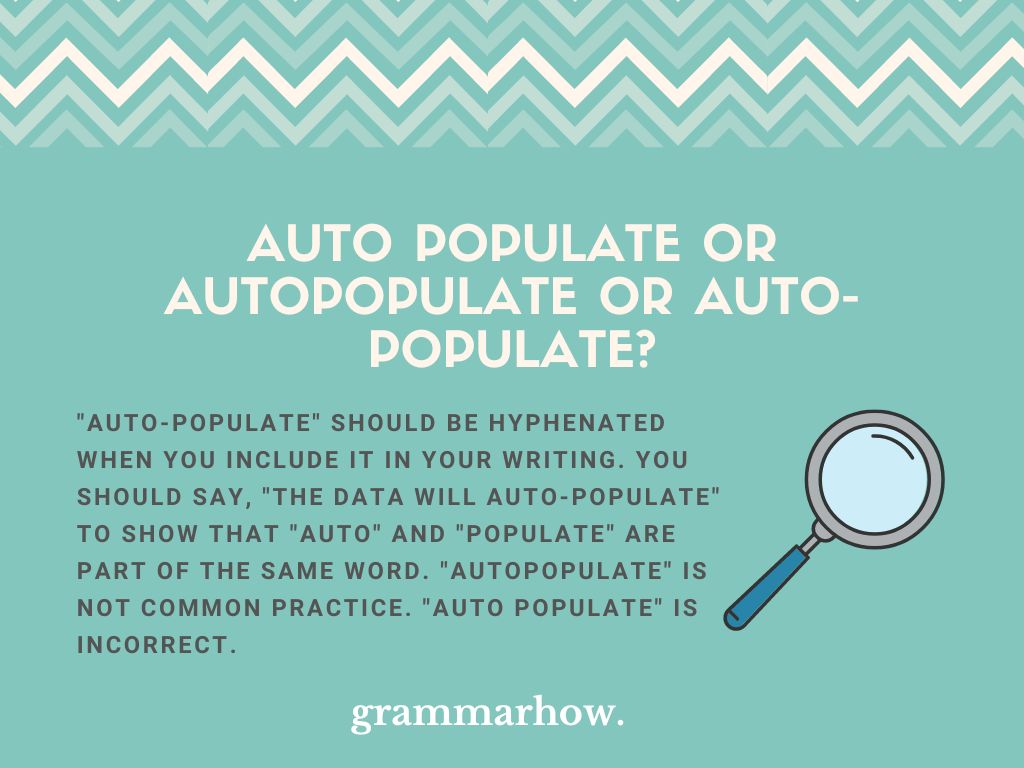It’s difficult to understand the rules associated with prefixes and hyphens. It seems that every prefix has a different rule attached to it, making it tricky to learn the ins and outs of each one. This article will explain the correct spelling of “auto-populate.”
Auto populate or Autopopulate or Auto-populate?
“Auto-populate” should be hyphenated when you include it in your writing. You should say, “the data will auto-populate” to show that “auto” and “populate” are part of the same word. “Autopopulate” is not common practice. “Auto populate” is incorrect.

When using prefix words, it’s best to follow standard style guide rules.
While most English style guides don’t specify which prefixes follow which rules, there is one overarching rule you can follow.
The Oxford Guide to Style endorses the hyphen between a prefix and root word with newly-coined prefixes (i.e. ones that haven’t been around for more than a few decades).
Since “auto-” refers to automation, it hasn’t been around for that long. “Automation” such as this has only been a thing since the age of technology came about. Therefore, you should use the hyphen when “auto-” is modifying a word like “populate.”
Is “Autopopulate” One Word?
“Autopopulate” isn’t often written as one word. Most official dictionaries do not recognize it in this form, meaning the hyphenated variation is the best option.
You should hyphenate “auto-” when it appears to show that it’s modifying the root word in some way. “Auto-populate” hasn’t been around long enough to succumb to the natural evolution of the English language.
Over time, unnecessary punctuation marks like hyphens tend to be dropped from common words. There’s a chance that “autopopulate” might become the most popular choice in the future due to native speakers preferring to drop hyphens in favour of simplicity.
For now, you should stick with “auto-populate.”
Is “Auto populate” Two Words?
You should never use “auto populate” as two separate words. “Auto-” is a prefix, meaning it must be attached in some way to the root word it is modifying. There are no exceptions to this rule.
The same rules apply regardless of the prefix you use. For example, you would say:
- Reentry
Not:
- Re entry
Adding a random space between a prefix and a root word is incorrect.
“Auto populate” does not work because “auto” cannot stand alone and modify “populate” in your writing.
- Correct: I’m going to need these to auto-populate with data. Can you do that?
- Incorrect: It hasn’t auto populated any of the information yet. Can you help?
Is “Auto-populate” Hyphenated?
“Auto-populate” should be hyphenated to keep it in line with most common English rules associated with hyphenating prefixes. When using newly-coined prefixes (i.e. ones that have only appeared in the last few decades), you should use a hyphen to separate them from the root word.
This is common practice, although many style guides avoid mentioning “auto-” as an example. This makes it more difficult to explain why “auto-populate” is used. However, it’s still correct to use this over any other form.
- The cells auto-populate when you need them to. I designed the system myself.
- It will not auto-populate until there is something new to add.
Conclusion
“Auto-populate” is the only correct form. You should stick to the hyphenated form because “auto-” is often hyphenated as it’s a newly-coined prefix in English.
While there are no specific style rules that point out how to use “auto-” appropriately, neither “auto populate” nor “autopopulate” are recognized by official English dictionaries.

Martin holds a Master’s degree in Finance and International Business. He has six years of experience in professional communication with clients, executives, and colleagues. Furthermore, he has teaching experience from Aarhus University. Martin has been featured as an expert in communication and teaching on Forbes and Shopify. Read more about Martin here.
